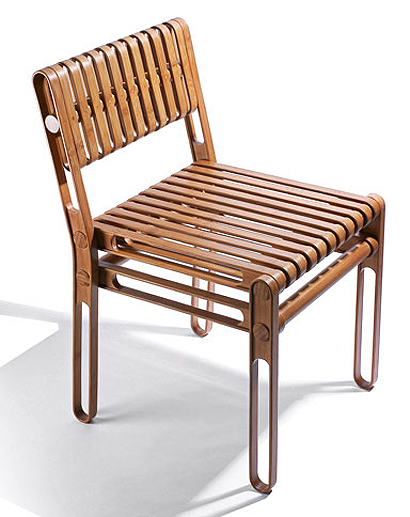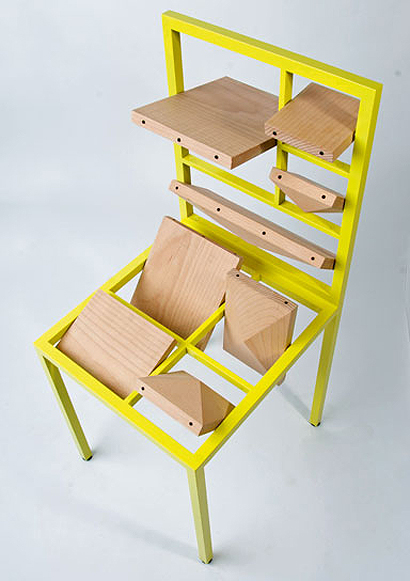|
Daniel Libeskind
Sawaya & Moroni
Altair
Altair, one of the closest stars visible to the naked eye, is the inspiration for Daniel Libeskind’s latest chair. True to the crystalline structure of its namesake, its folded stainless-steel form is also a reflection of the abstract geometries that characterise Libeskind’s architecture. With machine-polished surfaces that have been finished with a fine degree of abrasive to emulate the star’s luminosity, it certainly looks like it’s from another galaxy, although staying put on its mirrored seat might prove a bit of a bind.
Werner Aisslinger
BASF
Hemp Chair
The Hemp Chair, shown at the Poetry Happens exhibition in Ventura Lambrate alongside a taxidermy sheep, is the first monobloc chair made from natural fibres. “The renewable raw materials, hemp and kenaf, are compressed with a water-based thermoset binder to form an eco-friendly, lightweight and yet strong composite,” Aisslinger explains. Not yet in production, it has been designed for a lightweight manufacturing process used in the car industry, where natural fibre and acrylic resin composites are used for door linings and rear shelves.

Doshi Levien
Cappellini
Capo
The Capo (or Boss), the first collaboration between design duo Nipa Doshi and Jonathan Levien and Cappellini, is a lobby chair with a tubular base and wide cantilevered arms designed to envelop the sitter and offer a sense of privacy. “Its shape and materiality came from the image of a dapper gentleman in a well-cut suit with an upturned lapel and a felted hat,” say the designers of the chair, which has a light fibreglass frame and is upholstered in felt backed with leather. They are working on a matching sofa.

Idee Liu
Yii
Loop Chair
The stackable Loop Chair is inspired by ancient Chinese scrolls, which were also made from bamboo. Taiwanese brand Yii showed its range of hand-crafted curvaceous bamboo furniture, including chairs by the Campana brothers and Konstantin Grcic and a striking sofa by Yu-Jui Chou made of 999 hand-woven bamboo balls, at the Triennale Design Museum in an inflatable bamboo forest designed by Nendo.

Jan Plechac
Icons
One of the highlights of Salone Satellite was young Czech designer Jan Plechac’s range of outdoor furniture, Icons. Bravely taking on the likes of Josef Hoffmann, the Eameses and Gerrit Rietveld, he has repurposed six design classics for outdoor use by reducing their contours to a set of lines and recreating them in thick wire. On his version of Hoffman’s famed Kubus chair (pictured), Plechac says: “The wire version works to emphasise the geometric and graphic accuracy of the upholstered armchair. Like a graphic shortcut.”

Beta Tank
Taxing Art
At Ventura Lambrate, Berlin-based studio Beta Tank gave us some serious food for thought with its project Taxing Art. When pushed flat, the chair’s movable wooden panels make it a functional piece of design (taxed at 19 percent under German law) but flip them outwards and it becomes a work of art, subject to a tax of just 7 percent. Originally created for DMY Berlin last year, the chair (with matching table) questions whether there is a need to make distinctions between design and art in an evolving industry, as well as mocking the outdated European tax regulations that apply to each.

Jerszy Seymour
Magis
Flux
The Flux chair, a fluid design made from two continuous pieces of wire, is supposed to look as if the designer sketched the piece in the air, his hand hardly leaving the page. With versions in bright yellow, blue and red, Flux
was one of the brightest things on the Magis stand this year, with only Alessandro Mendini’s industrial version of his famous Proust chair and Ron Arad’s rotationally moulded Raviolo seating giving it a run for its money.

|
|
Image
Sawaya & Moroni (top imaage)
Words
Riya Patel and Christopher Turner
|